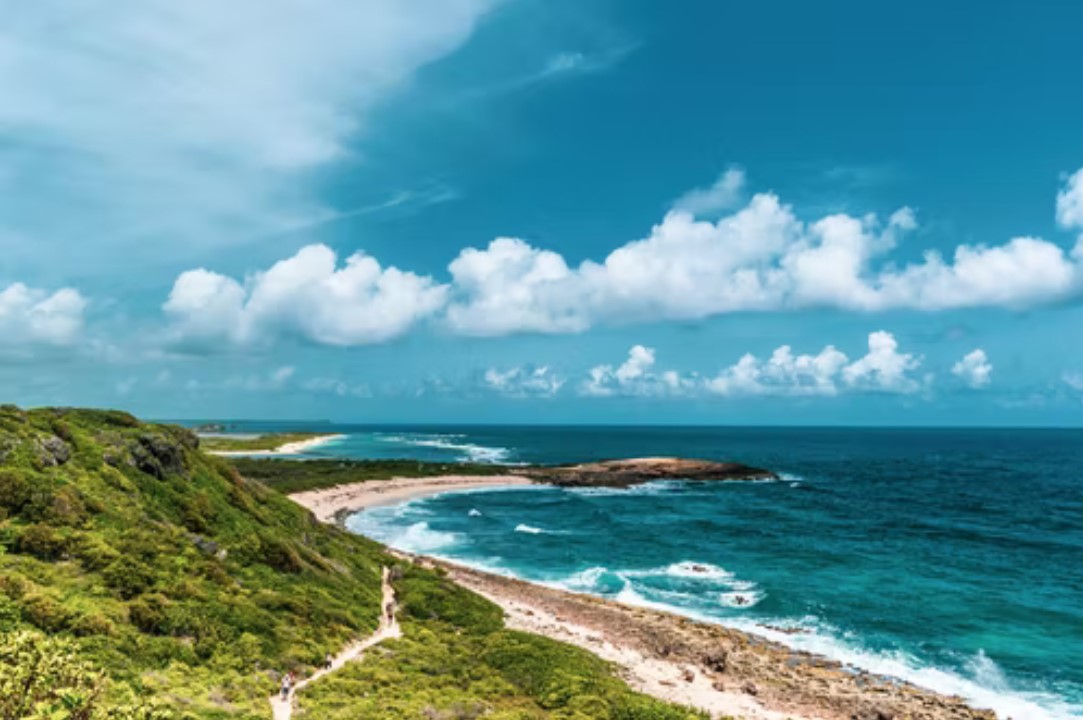Guadeloupe is a beautiful location to visit because of its evocative combination of lush natural beauty and rich Creole and French culture. The archipelago is a French overseas territory, and Guadeloupe’s cuisine, language, and culture reflect this close relationship.
On a map of Guadeloupe, the main landmass resembles a butterfly, with two main islands: Grande-Terre to the east and Basse-Terre to the west, divided by the Rivière Salée, a thin mangrove waterway.
Terre-de-Bas Island, Les Saintes, Guadeloupe
Terre-de-Bas is the western island of Les Saintes, and it is much larger but sleepier than Terre-de-Haut. It has small fishing communities, bathing beaches, and lush hiking routes, and is considered one of the most natural and wild islands in the Guadeloupe archipelago.
On Terre-de-Bas, Grande Anse has a modest 17th-century chapel, a beautiful cove, and a beach with bungalows for swimming and snorkeling. Hikers can also follow the path to the 273-meter-high Grande Montagne promontory.
Gros-Cap is Terre-de-Bas’ major settlement, featuring a ferry dock, restaurants, and places to stay close, as well as road and hiking path starting locations.
La Désirade Day Trip, Guadeloupe
La Désirade, which translates as “The Desired One” in French, is a great place to visit if you want to get away from the throng. This tranquil island is located on the southern coast of Grande-Terre, about a 45-minute rough boat journey from Saint-Francois.
La Désirade, the oldest island in the Lesser Antilles, is made mostly of tabular rock and was previously a leper colony. It now serves as a geological nature preserve.
The island is surrounded by beautiful palm-lined beaches like Fifi and Souffleur, while coral reefs defend the island’s coastlines. Snorkeling, swimming, and diving are all popular sports, and a hiking track near Le Morne du Souffleur provides breathtaking views of the ocean. During your tour, you’ll also encounter a lot of iguanas and goats.
The Petite-Terre islands, located near La Désirade, are two deserted island nature reserves notable for their biodiversity.
Shopping at Pointe-a-Pitre
Guadeloupe’s greatest bargains may be found in Pointe-a-Pitre, the archipelago’s main town. The Center Saint-John Perse, as well as the boutiques along Frébault, Nozières, and Schoelcher Streets, attract consumers with French fragrances, jewelry, cosmetics, crystal, and fashion.
The colorful outdoor markets are fun places to visit, as much for their ambiance as for their merchandise, with many market vendors dressed in colors as bright as the tropical fruits they flaunt. The saint-Antoine market offers a zingy sampling of Creole flavors and Guadeloupe food products.
Spices, flowers, crafts, and apparel are sold in the harborside market, and fishing boats dock here to sell their catch.
Terre-de-Haut Island, Les Saintes, Guadeloupe
The eastern island of Les Saintes, Terre-de-Haut, has a more European feel to it than its western counterpart, Terre-de-Bas. Because the topography and temperature were unsuitable for sugar production, the inhabitants were mostly fishermen.
The pastel-colored buildings and vividly painted fishing boats (saintoises) give lovely photo possibilities today, and the island is a calm area to simply stroll about and absorb a bit of local life.
The majority of visitors take a 30-minute boat from Bass-Point-a-Pitre Terre’s or Trois-Rivières and rent a scooter or golf cart to explore the island.
The “Sugarloaf” volcanic peak overlooks a curving blue beach bordered by white sand at Bourg des Saintes, the island’s largest hamlet. With whitewashed walls, red-tile roofs, and vibrant gardens studded with tropical flowers, the buildings here have a European feel to them. Stop by a boulangerie (bakery) for a nice treat after meandering about the hamlet.
If you’re looking for a relaxing day at the beach, Plage de Pompierre is a peaceful, curved bay with picnic seats and swaying palms, whereas Craven is wilder.
The 17th-century Fort Napoléon, with its historical museum and Exotic Garden, is on a hill overlooking the harbor and is one of the island’s most popular tourist attractions.
The ascent to Morne du Chameau, the island’s highest peak, takes around two hours from Terre-de-Haut town. Ilet à Cabrit is a tiny island across the water where the remnants of the 19th-century Fort Joséphine may still be seen.
Marie-Galante Island, Guadeloupe
Marie-Galante, often called the Big Pancake by its residents, is a circular, flat island famed for its beautiful beaches. Sugar cultivation and tourism are the main businesses, and several windmill remains can be seen across the island.
On Marie-Galante, sunbathing, swimming, and hiking is popular activities, and it’s always wonderful to take up the local spirit and join community events.
Château Murat was Guadeloupe’s largest sugar plantation when it was built in 1839, and its eco-museum commemorates Marie-arts Galante’s and culture, particularly the sugar industry’s history. A restored colonial home, windmill tower, the remnants of the sugar industry, and a medical garden are included on the grounds.
With pillowy-soft white sand and turquoise sea, Feuillere Beach and Anse Canot are two of the greatest beaches on the island.
Plage du Souffleur, Grande-Terre
Plage du Souffleur, one of Grande-most Terre’s beautiful beaches, fringes the shore of Port-Louis, a small fishing community on the island’s northwest coast. This lovely length of white sand and the azure sea is surrounded by sea grape bushes and coconut palms, providing lots of shaded spots to spread out your towel.
You could find some excellent waves for body surfing here depending on the weather, and snorkeling can be interesting when the ocean is quiet. Food trucks provide Creole cuisine and beverages.
Brightly painted wooden buildings and old iron lampposts in adjacent Port-Louis give the area a cheerful vibe. On clear days, a 20-minute drive through desert vegetation leads to Pointe de la Grande Vigie, Guadeloupe’s northernmost point, offering panoramic views over the sea to neighboring islands.


0 Comment